
Photo by Howard Owens.
Data centers are big, noisy, use too much energy, and pose a risk to watersheds, more than two dozen speakers told the staff of the Genesee County Economic Development Center at three public hearings on Monday in the town of Alabama.
The hearing was held at the rec hall of the Alabama Volunteer Fire Department and was attended by more than 50 people. Some brought signs or wore T-shirts expressing their opposition to locating a data center at WNY STAMP.
They came from Syracuse, Buffalo, Rochester, Niagara County, Orleans County, and Genesee County, including the Tonawanda Seneca Indian Reservation.
The proposed projects are massive -- all more than 750,000 square feet, or more than 13 football fields -- and will range in cost from $2.2 billion to $6.32 billion. They would each create from 100 to 200 jobs.
The three projects are STREAM U.S. Data Centers, LLC, Project Rampart, LLC, Potentia Holdings, LLC.
Exactly what kind of data the proposed centers would store and retrieve is unclear, but data centers typically provide services for artificial intelligence, cryptocurrency data mining, data analytics and storage, IT and telecommunications, and co-location services for major corporations.
Stream Realty Partners builds data centers for Fortune 500 companies. PRP Real Estate Investment Management backs Project Rampart, and its clients include Meta (Facebook), Microsoft, and Amazon. Potentia Capital is an Australian private equity firm specializing in technology, software, and tech-enabled services.
These sorts of projects are usually backed by a consortium of private equity investors, often global in nature.
CORRECTION from prior version of the story: Neither Steam nor Project Rampart are seeking property tax exemptions, just sales tax and mortgage tax exemptions. The Stream project would generate $10.9 million in annual revenue for local municipalities and school districts, and Project Rampart, $10.3 million annually. Potentia is seeking $42.7 million in property tax exemptions over 20 years, resulting in an average of $7.1 million in annual PILOT fees.
Many speakers questioned whether data centers fit into the promised profile of WNY STAMP, which was sold to the community as a high-tech manufacturing hub, much like the Edwards Vacuum plant currently under construction.
Edwards is promising 600 jobs in a 240,000-square-foot facility, or one job per 400 square feet. Stream is projecting one job (at a salary of $89,000 annually) per 7,800 square feet, Rampart, one job ($64,000 annually per 7,142 square feet, and Potentia, one job ($129,000 annually) per 4,460 square feet.
There is only enough space available in STAMP for one of these data centers, so the GCEDC board will need to decide whether to reject all of them or pick only one of them for approval.
Data centers have been controversial in other communities, and several speakers brought up issues with the Digihost Fortistar Niagara County facility. It is a 60 MW cryptocurrency mining operation located off Erie Avenue in North Tonawanda. Residents there have protested against noise pollution, leading the city to ban the facility from expanding for two years.
Other complaints about the facility have included excessive greenhouse gas emissions,
There have also been complaints about noise from data centers in Loudoun County, Virginia, Granbury, Texas, and Fairfax County, Virginia.
Health concerns from data centers include stress and anxiety, hearing loss, disrupted sleep, and even cardiovascular risk.
The controversy in Niagara County about data centers may have contributed to chasing away Kevin O’Leary, of Shark Tank fame, when he sought to build a data center in the region. He claimed the project was fully funded and would have created thousands of jobs. He said he ran into significant roadblocks raised by local politicians and state policies.
He reportedly said on CNN, "It got so bad with the politicians in the local region and the state policy, we moved it to Norway, and all the jobs. Norway has it now. Thousands of jobs coming out of that! That’s New York. Uninvestable.”
While many speakers on Monday focused on these issues, the only matter before the GCEDC board, when the projects come up for a vote, is economic -- will a data center create jobs and help grow tax revenue in Genesee County? NOTE: The environmental issues will come before the board during the SEQRA, if GCEDC is lead agency.
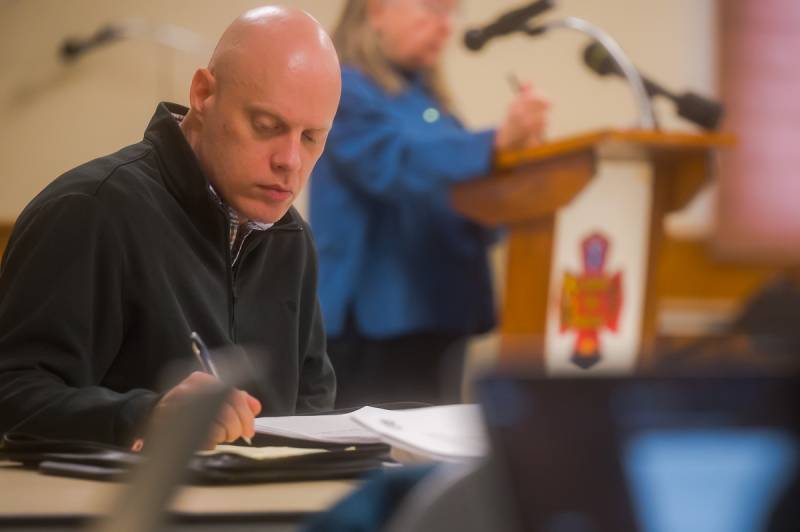
Photo by Howard Owens.
If approved by the board, the winning project must jump through a series of regulatory hoops, including:
- State Environmental Quality Review Act (SEQRA) compliance, which assesses potential impacts on air quality, water resources, wildlife, and other environmental factors. GCEDC has applied for lead agency status for the SEQRA review.
- Air and Water Quality Permits, which cover air emissions and water usage. It would be up to the Department of Environmental Conservation to provide the permits.
- The project must comply with the Climate Leadership and Community Protection Act (CLCPA), which focuses on greenhouse gas emissions. There would also be a requirement for energy consumption disclosure.
- The town of Alabama's local zoning boards and the Genesee County Planning Board would review the projects. The project would need to comply with existing noise ordinances, for example, as well as other land-use regulations. As part of the public hearing process at the local level, the developer would need to address community concerns about noise, emissions, and resource usage.
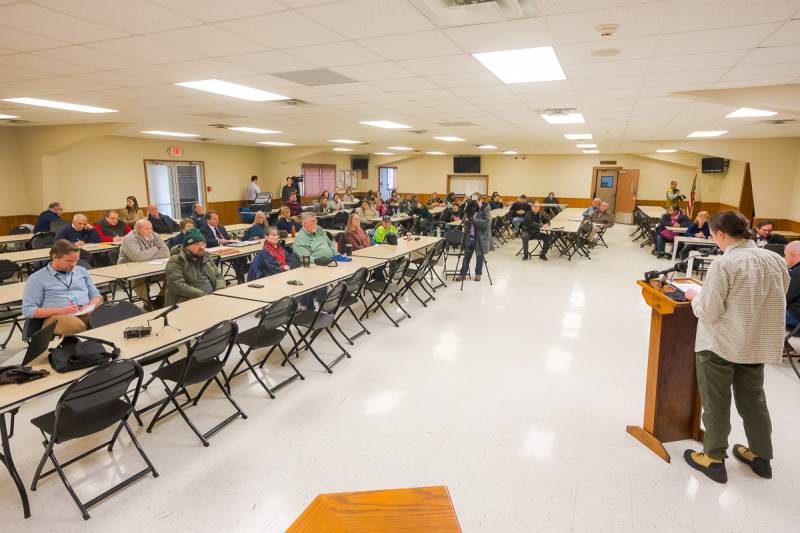
Highlights of speakers' remarks (not all speakers included):
Madeline Nyblade, an assistant professor at SUNY ESF with a Ph.D. in Earth and Environmental Sciences, specializing in hydrology.
Nyblade expressed concern about the hydrology of the region, which includes wetlands and clay-rich soils that create perched water tables. The area is upstream from critical ecosystems such as the Tonawanda Seneca Nation lands, the Tonawanda Wildlife Management Area, and the Iroquois National Wildlife Refuge, making it susceptible to downstream impacts.
“This land is wetland, part of this larger wetland complex, yet none of the proposals take into account the wetlands that will be destroyed,” she said.
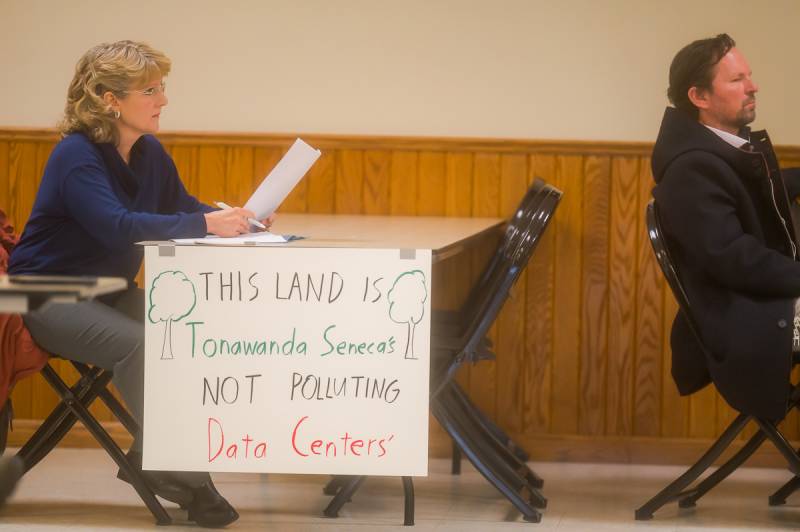
Margaret Wooster, reading a letter from Allies of the Tonawanda Seneca Nation, Western New York Environmental Alliance, and 57 other environmental, faith-based, human rights, and good governance groups.
The letter states that the project contradicts New York State’s and international commitments to environmental sustainability, social responsibility, and long-term stewardship and expresses concerns about the destruction of wetlands. The data centers will consume 200 megawatts of electricity annually, straining regional energy systems, she said. The centers would also use 800,000 gallons of fresh water daily. She also raised concerns about air pollution.
“Industrial runoff, hydrological disruptions, and heated water discharge from a data center would devastate these fragile ecosystems,” she said.
Joseph O’Malley (reading a statement by John Whitney)
The letter noted the area is a 20,000-acre network of wetlands and wildlife refuges critical to biodiversity and carbon sequestration.
“The GCEDC STAMP site is situated in an area with deep cultural and ecological significance," the letter stated. "It is central to Western New York’s heritage, including that of the Haudenosaunee people and the Tonawanda Seneca Nation.”
It also called into question the "excessive" financial incentives given the limited number of jobs expected.
“Public funds should not be used to incentivize these uncertain benefits, not without first conducting an independent economic analysis of the costs and benefits,” he said.
The long-term costs could outweigh any short-term financial gains, he said, especially if rapid technology advancements render the facilities obsolete in a few years.
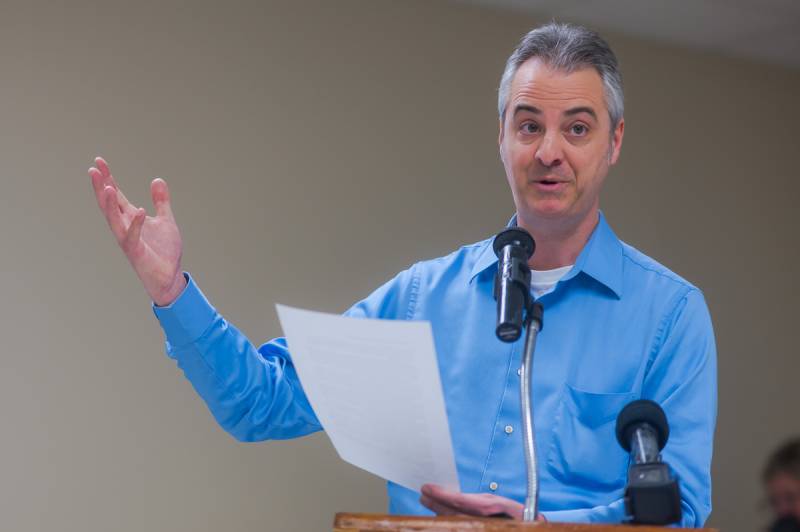
Photo by Howard Owens.
Dr. Kirk Scirto, a family physician who treats patients from Tonawanda Seneca Nation and is a public health specialist
He said the data centers would emit at least 500 tons of carbon dioxide annually and burn 60,000 gallons of diesel fuel per year, leading to air pollution that disproportionately affects the nearby Tonawanda Seneca Nation. The noise, he said, would be 50–90 decibels, "akin to jet engine noise." The projects he said are a threat to The Big Woods, a key hunting ground for residents of the reservation. Water usage, he said, would deplete resources for the surrounding counties. The superheated discharge water, which could also contain toxins, could harm downstream fisheries. If the centers are used for AI, AI could lead to significant job loss throughout the United States.
"In medicine, we study how parasites suck up the nutrients or resources while harming them," Scirto said. "Well, that's exactly what these data centers are -- parasitic centers that would suck up an immense amount of the drinking water of Niagara, Orleans, Erie and Genesee county residents. They would also steal a huge amount of their energy in exchange for a barrage of contamination. What's more, hardly any jobs would be offered to local residents."
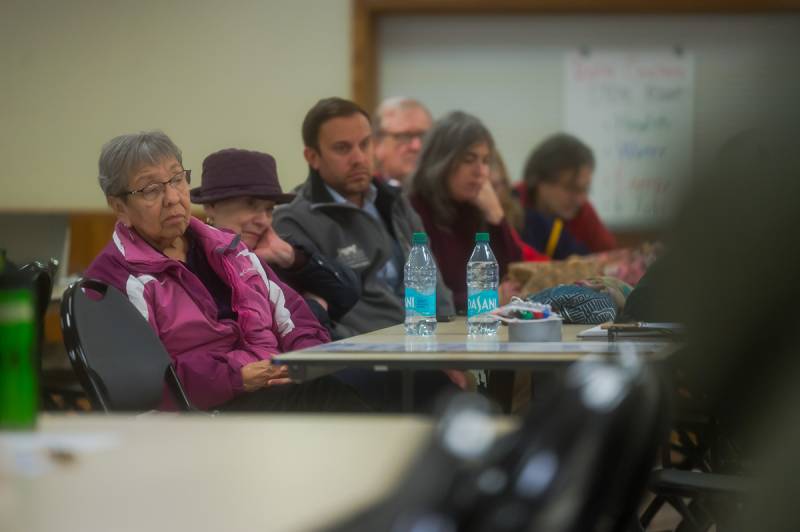
Diane Sirczyk, representing the Atlantic Chapter of the Sierra Club
"Data centers around the country are notoriously dirty and noisy consumers of vast amounts of electricity, which are straining electric grids, emitting large volumes of greenhouse gas pollution and undermining our country's ability to transition away from fossil fuels," she said.
She noted that Project Potentia, if approved, would require 195 megawatts of electricity per year, which is enough to power about 32,000 homes.
She suggested the data centers would not comply with CLCPA.
Barbara Jonathan
Jonathan said she lives near Big Woods. She expressed concern about the impact on future generations, given the potential for a negative environmental impact. She expressed concerns that the data center will have no accountability and no relationship with the local community once built.
“Where are these people who operate these data centers? Are they going to really give a damn about you or me?” she said.
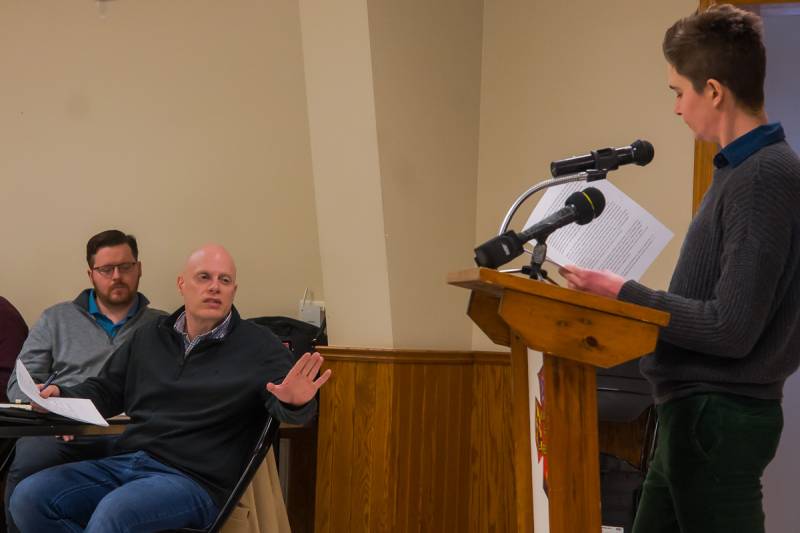
Photo by Howard Owens.
Sarah Howard, a resident of Syracuse
Howard opposed the incentives and criticized GCEDC for a "lack of transparency" and "procedural flaws."
She expressed environmental concerns, concerns about energy consumption, and a lack of a significant number of jobs created by the projects.
“The revised EAF states no water is needed for cooling but includes an 8-acre retention pond holding 10 million gallons. This raises serious questions about transparency," she said.
Howard was the only speaker who steadfastly refused to stop talking at the end of her time limit.
Maggie Cowen (reading a statement from a person named George)
Cowen noted that wastewater from a data center could contaminate Orleans County rivers and creeks, ultimately reaching Lake Ontario and affecting its growing tourism industry, notably fishing. Cowen noted that a data center in Niagara County generates noise levels from its cooling fans of 85 decibels. Cowen argued that a data center provides no meaningful value to the community.
Cowen fought back tears near the end and said, "I've got a little bit more time, so I just like to say, like, this is one of the few natural areas remaining in this region of the state, and it seems ridiculous to throw away."
Evelyn Wackett, Buffalo resident and environmentalist
The STAMP project threatens endangered and threatened species, she said, including the short-eared owl, northern harrier hawk, monarch butterfly, and bog turtles. She said a data center would draw six million gallons of water from the Niagara River daily.
“Yesterday was World Wetlands Day," she said. "I want to celebrate the wetlands. I don’t want to see them destroyed.”
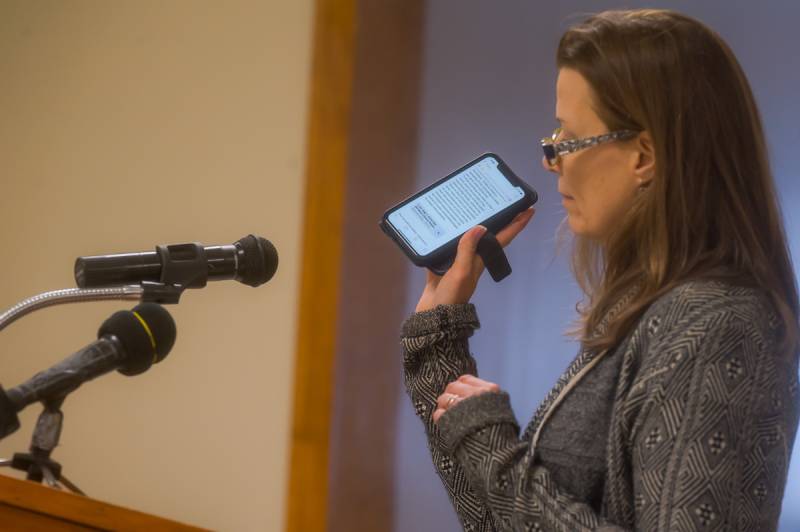
Photo by Howard Owens.
Kristen Moser, a wildlife photographer from Syracuse
Moser said these projects do not belong near the Tonawanda Seneca Nation or the surrounding wildlife refuges, including the John White Wildlife Management Area, Iroquois National Wildlife Refuge, Tonawanda Wildlife Management Area, and Oak Orchard Wildlife Management Area.
“The Big Woods is home to over 100 species of birds, many of which are dependent on undisturbed areas to reproduce,” she said.
She played a recording of birds singing in the woodlands and then a recording from the same spot when a supply truck for one of the STAMP projects passed by. The birds were silent and only the truck could be heard.
"That's what you'll be hearing if these three data centers go in," she said. "If any of this continued destruction continues, the data center would be one of the closest complexes to this exceptional forest. The sound of the trucks will be multiplied by the constant industrial sounds of the center. Noise pollution will not only impact and displace wildlife in the Big Woods, it will forever destroy the peace and serenity of this sacred land for the people of Tonawanda."
Katie Rivers, Alabama
Rivers said she has lived near the project site for 30 years. She said development has already disrupted local wildlife, particularly deer, which have been displaced from their natural habitats. She suggested economic developers and planners prioritize corporate interests over community welfare.
“It seems like you’ve all been bamboozled," Rivers said. "I can’t even imagine that you think this could be beneficial to anybody in the town.”

Photo by Howard Owens.
Angela Carlson, from Oakfield, now living in Batavia
She claimed that a cost-benefit analysis has not been produced, violating General Municipal Law 859-a. She highligned the environmental risks of the project and its potential adverse impact on threatened species such as the northern harrier and short-eared owl.
She called on GCEDC to produce a cost-benefit analysis, disclose the names of the owners and operators of the projects, conduct a comprehensive noise study, and provide more opportunities for public participation.
“One cannot claim to care about the environment while continuing to disregard and disrespect the rights of Indigenous peoples,” Carlson said.
